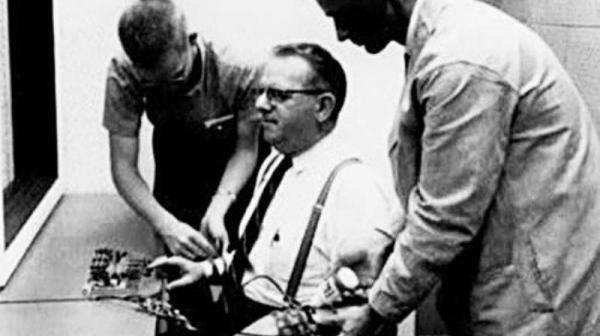
Image: Xatakaciencia
At the beginning of the 60s of the last century, the American psychologist Stanley Milgram carried out a social experiment that later became famous, that is, an experiment in obedience to authority. Documentaries and novels, plays and television series were devoted to his famous shock machine; they even inspired an episode of the Simpsons, a French awards game, and a TV movie with John Travolta. Therefore, in this Psychology-Online article we will discover together Stanley Milgram's obedience to authority experiment. We will see what it consists of, the objectives, the criticisms and the surprising conclusions of the Milgram experiment.
Index
- History of the Milgram experiment
- Results of the Milgram experiment
- Objective of the Milgram experiment
- Conclusions of the Milgram experiment
History of the Milgram experiment.
Between 1960 and 1963 the psychologist Stanley Milgramfrom Yale University recruited 40 random white and male volunteers (blue-collar workers, clerks, professionals, etc.) for what they believed was a paid memory study. The distribution of the roles of the student and the teacher:
- The "teachers", who were not familiar with an experiment other than the one explained.
- The "students", accomplices of the experimenter.
The volunteers were led into two separate rooms, and the teacher was placed in front of an electrical control panel composed of several buttons under which the voltage and degree of danger of the discharge were written. The teacher then had to read pairs of words to the student and propose associations, then determine if the answer given by the student was correct.
The teacher was initially subjected to a "test" with a 45 volt electric shock for the student, then he personally proceeded to question the other (who never he managed very well to remember the words to memorize) administering shocks of increasing intensity, from mild shocks (marked on the button as "mild shock") to go up, in steps of 15 volts, to a regime of 375 volts (marked "danger: serious shock") and finally to 435 and 450 volts, simply marked, on the button, with X. The victim, in the other room, was tied to a kind of electric chair; the volunteer, a short distance away, could not see her but heard her sounds.
In fact, when the student made a mistake, the teacher had to inflict a stronger and stronger discharge and the experimenter, for his part, constantly encouraged the teaching subject to continue and carry out the experiment, even when they were perplexed or reluctant to continue the questioning and downloads.
Results of the Milgram experiment.
The degree of obedience was measured based on the last switch pressed, and 65% of the people reached the end of the test, despite the caveat that the shock could have caused serious, even lethal, consequences when student. 26 out of 40 subjects continued the experiment up to a maximum of 450 volts; no one refused to continue before reaching 300 volts. The experiment was repeated in different circumstances and with variations in the method, always with similar results. After the experiment, the volunteers were told the truth, and what had happened was calmly discussed.

Image: Behavioral scientist
Objective of Milgram's experiment.
Milgram was the son of Jews who had fled Eastern Europe during World War II and wanted to understand, like so many in his condition, why the Germans had collaborated in the extermination of the Jews. From the beginning, the psychologist, in fact, presented his study as the definitive explanation of the Holocaust.
Milgram's experiment conclusions.
East implausible and frightening degree of obedience that drives human beings to violate their moral and ethical principles it has been explained by Milgram with the subordination to an authority that the subject considers legitimate and that, therefore, induces a state of heteronomy.
The state of heteronomy It occurs when a subject no longer perceives the options and actions that he performs as his own, precisely because they are governed by an external order. This state produces a depersonalization. By explaining the factors that contribute to determining this state of heteronomy, the American psychologist makes us understand why there are submission, law of silence and code of honor induced in such a state:
- The first factor is the conviction of the subject of the legitimacy of authority.
- The second factor is the adherence to the system which leads to the conviction that obeying is the right thing to do and about what is not discussed.
- The third factor is the social pressure.
Everything was in authority: Milgram showed the human being as a creature that blindly carries out orders. In the basements of Yale University, adults have turned into unconscious children, into dogs that obey whoever orders "sit down," "give me the leg," or "jump in the gutter." They made all Nazis think that, after the war, they kept repeating a three-word phrase: "befehl ist befehl", orders are orders.
In Milgram's experiment, it is explained that the danger is that, If the individual accepts the ideological definition of the situation proposed by the authority, even a destructive and immoral action ends up being considered reasonable or necessary.
In the following article you will find other interesting psychological experiments.
This article is merely informative, in Psychology-Online we do not have the power to make a diagnosis or recommend a treatment. We invite you to go to a psychologist to treat your particular case.
If you want to read more articles similar to Stanley Milgram's obedience to authority experiment, we recommend that you enter our category of Social psychology.
Bibliography
- Bregman, R. (2019). A new (not cynical) history of humanity. Milan: Feltrinelli Editore.
- Jervis, G. (1977). The good re-educator. Writings on the uses of psychiatry and psychoanalysis. Milan: Feltrinelli Editore.
- Verona, C. (2018). What a mental illness it is not. The derivations of the Italian institutional psychiatric system. Tricase: You can print.


